Although I can picture my father with a cigarette in his hand, or pinched between his lips while he was working on something, I can’t find a photograph. Of course it was seldom that he wasn’t behind the camera instead of in its focus, and a cigarette was just not part of any formal photos with his family. But Dad was a smoker probably half his life. He may have started at an early age, but it was the availability of free smokes in the Army that got him fully hooked. But when he decided to quit, that’s just what he did.
In the crib
The earliest smoking story is recalled often by my Mom, Dorothy, and dates to my Christening on November 29, 1953. After the baptism, the family returned Elizabeth Drive, and Mom’s mother was quite upset that ‘all the men were standing over the baby smoking.’ I am sure the ‘men’ were my father, his brother Joseph F. Conlon, and their father Martin J. Conlon, who were there that day. My maternal grandfather, James Vincent Victor Figueroa, smoked a cigar each day (his grandchildren would beg to be rewarded with its ring), but I imagine he had already been well trained after eight children with my grandmother, Barbara Marie Reinhard Figueroa.
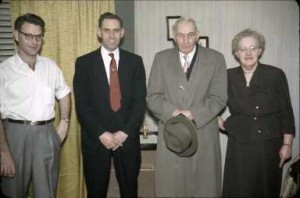
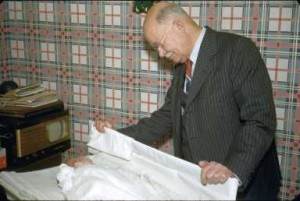
Afterwards, Mom would not allow any smoking in the children’s rooms, and Mom is insistent that her mother was ahead of her time in understanding the delicacy of infants’ lungs, attributing this to her mother having worked for a Doctor.
L.S.M.F.T.
Dad smoked one to two packs of Lucky Strike cigarettes each day. From an early age we learned that the abbreviation on his brand, L.S. M.F.T. stood for ‘Lucky Strike Means Fine Tobacco.’
![Bill holding pack of Lucky Strikes in living room at 9 Elizabeth Drive. [1954]](https://william-martin.conlon.org/wp-content/uploads/PCD0853.IMG0092-300x199.jpg)
Lighters
Generally he used a Zippo lighter. I can still remember the smell of lighter fluid, when Dad would flip it over to remove the cover and re-fill it. He kep the cans of lighter fluid in the utility cabinet in the kitchen, along with the flints, which were easier to handle with my small fingers, so we kids would get to help put in a new flint. When driving though he usually used the electric lighter in the dashboard.
Ash Trays
Naturally there were ash trays around the house. I remember he had a round orange glass tray, about eight inches diameter that was on a stand next to an easy chair. There was also an elegant chrome plated tray with two intertwined pelicans with open beaks to hold a cigarette. My favorite, and maybe Dad’s, was the alligator tray. It was often on the kitchen table, but also found its way to electronics projects because the soldering iron could be rested against it without danger of cracking glass or discoloring chrome.
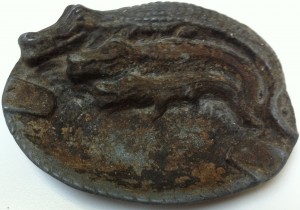
Of course, ashes sometimes fell off of their own accord, and there was some upholstery and discolored furniture; I remember cigarette burn’s on Dad’s night stand. I remember thinking it was humorous once when the butts were dumped into the kitchen garbage can, which started smoldering from a butt which hadn’t been fully extinguished. After this event, butts were only emptied into a metal can outside the kitchen door.
Driving
In 1958, Dad replaced his 1949 Chevy with a new 2-door black Chevy Biscayne, which he sold in 1966 when we moved to Houston, where air conditioning was a must.
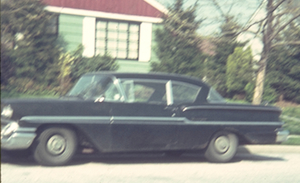
For many years, Dad’s habit was to flick the cigarette butt out the vent window, or when the weather was warm, it could go right out the driver’s side window. But one hot summer day, when all the windows were rolled down, the butt came back inside and landed on the back seat where it started to smolder.
Determined to prevent this from happening again, Dad acquired and installed a version of the Chevy Flameout Vacuum Ashtray. This was an accessory that he mounted on the driver’s side under the dashboard. It included a glass mason jar to collect the butts, a short section of tubing into which a butt was placed, and a spring loaded valve, which when depressed would expose the jar to engine vacuum via a vacuum hose snaked through the firewall to the intake manifold. Dad would insert his butt, press the button and the butt would get sucked into the jar, where it would be quickly extinguished.
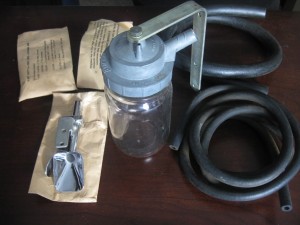
The Flameout Ashtray was available as a Chevy Accessory, although I think Dad probably bought his from J.C. Whitney or some equivalent. About once a week, Dad would un-screw the jar and dump the butts out — a very nice system. It was also something unusual and an interesting topic of conversation for guests.
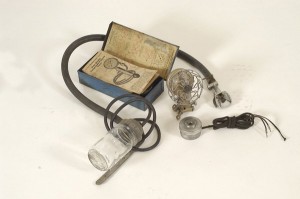
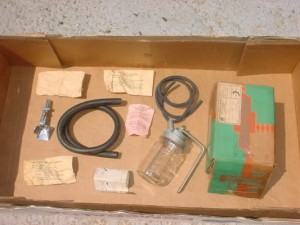
Smoker’s Cough
Dad had a very distinctive smoker’s cough, and we could always locate him by sound when he wasn’t within view, most often when we went shopping. There were two stores that we often would visit after dinner during the week. Pergament’s was a department store, which with an emphasis on home improvement, which in the mid 1960s opened a new store at 3901 Hempstead Turnpike in Bethpage, NY 11714 on the corner of Hicksville Road, across from Nunley’s Happyland Amusement Park. Another was Times Square Stores, which opened a few years later just up the turnpike near Wantagh Avenue. During the summer, we would also stop by the pool supply store to buy chemicals, or parts for the pump and filter. But wherever we went, we always knew where Dad was.
In the late 1950s and early 1960s, Dad kept over the counter codeine lozenges in the car to soothe his cough. In those days before seat belts, I could sometimes coax him to share one with me as I stood on the transmission hump while holding onto the back of the bench seat.
Cigarette Box
In ninth grade wood shop at Clear Creek High School, my big project was building a box to hold a carton’s worth of cigarette packs, so they could be easily dispensed. I cut pieces of plywood to size, joined them into a box with an open top and opening at the bottom front for removing a pack. After sanding. staining, and finishing, I brought it home to give to Dad. It hung on the wall of the kitchen in Bethpage, above the phone, and Dad used it for many years to hold his cigarettes. Later, he attached a thermometer to it.
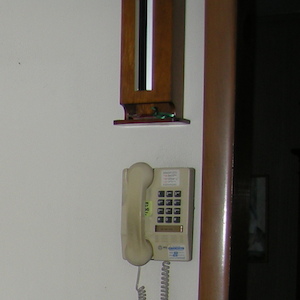
Cold Turkey
In the late 1970’s Dad was working at Grumman’s Calverton facility and was late for a meeting on the second floor of another building. He dashed out and bounded up the steps. By the time he reached the first landing he was out of breath and felt like he was going to have a heart attack. We don’t know whether he saw the on-site doctor, but he quit smoking that day: cold turkey.
To substitute on the hour long drive from Bethpage to Calverton, he would suck on hard candies, ultimately settling on Werther’s Originals, which he would invariably offer to his passengers: “Would you like to have a Werther’s?”. Quitting like that was a remarkable feat of self discipline, especially since smoking was not only allowed in the workplace but quite common. And he also car-pooled out to Calverton, and I imagine some of his co-workers smoked en route, just as he had.
And that was it. Never another cigarette smoked in the house.